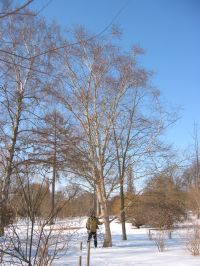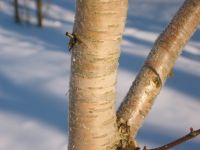Gold birch, Ermans birch - Betula ermanii
English name:
Gold birch, Ermans birch
Scientific name:
Betula ermanii
Family:
Betulaceae (Birch family)
Height:
5 - 20 m.
Flowering:
Early may
Range:
N.E. Asia: Japan, Korea, China & Russia
 |
 |
 |
The 52 year old Betula ermanii in the picture is from seed collected by Bertil Lundqvist on Mt. Fuji, Japan in 1952. It can be found about 5 meters beyond the second grass plain and on the north side of the lake road (Søvejen), in square 1310 position 1301.
Plant description:
Winter came late to Denmark this year. January was warm with a new record high temperature, but now when its time to think about the plant of the first month of spring, March, we are having nights with temperatures below -10 °C, and snow everywhere. Under these conditions I decided it would be an idea to find a tree with nice bark, like one of our birches. The rich variation in bark makes our birch collection one of the more interesting parts of the arboretum in winter.
The genus Betula is estimated to contain 102 species, all coming from the temperate regions of the northern hemisphere. In our collections we have 34 species, or about one third of all those known. We have 45 specimens of this months plant Betula ermani. All but one of these are documented, wild-collected plants which make them valuable for research and conservation. Our specimens come from Korea, Japan and Russia (Sakhalin Island and Kamchatka Peninsula). They come from as far south as 33 °N and as far north as 56 °N, a span of 23 ° in latitude.
Betula ermanii was first reported in Denmark in 1892. Ninety years later, in 1983 it was reported to still be fairly rare. Our oldest accession of this species occurred in 1937 but it is no longer alive. The Arboretums oldest living specimen is from 1953 and is in the main picture and the picture of the twig with the male catkins.
Betula ermanii is a quite variable deciduous tree. At this time of year, the outer most sheets of bark are rather white (if not covered with algae because of heavy nitrogen deposition), but they are easily pealed away in horizontal strips, revealing, most commonly, a pinkish or apricot coloured bark underneath, or in some cases a much darker copper-red bark. The one-year-old twigs are warty and the buds pointed. The male catkins, which can be seen now, also have a warty appearance. The leaves are 6-9 x 5-6 cm with 7 to 12 pair of (sunken on the upper surface) parallel nerves. The leaves are triangular-egg shaped with a cut off or wedge shaped base. The leaves have a pointed tip and are sharply saw-toothed. The upper surface is shinny dark green. The underside sometimes has tufts of hair in the axils of the nerves and is glandular. The leaf petiole has dark brown glands and is usually hairless. Autumn colour is bright yellow. This species is very similar to Betula utilis, but this latter species is not reported to have glands on its leaves.
A significant variation in bark colour can be seen on our plants. From silvery-white (Mt. Halla San, on Jeju Island, South Korea) to copper-red hues (one from Mt. Fuji, Japan). Most barks however would best be described as being creamy pink or apricot in colour. Growth rates also vary strongly as does tree shape, some being multi stemmed like a bush, while others have formed a single straight bole. Such variety could well be used to develop fine new cultivars. Interestingly, our slowest growing plants come from the far north in Kamchatka and from the far south, Jeju Island in Korea.
A closely related taxa from Mt Apoi on Hokkaido Island in Japan, was received by us in 1962 from the Botanic Garden in Gothenburg Sweden. Not only is it interesting because it is reported to grow on serpentine soils, but scions from our tree have already found their way into the horticulture trade and are sold in under the names Betula apoiensis. We have temporally classified it as Betula ermanii var. apoiensis based on information from Kew gardens. Like the mountain birch in Scandinavia, Japanese research suggests this taxon may be a hybrid swarm. It is limited to two populations occurring on ridges of Mt Apoi and it is considered to be critically endangered. Although not intentional, a wide distribution of this species in gardens may one day play a role in protecting it from extinction.
References:
Bean, W.J. 1976 Trees and Shrubs Hardy in the British Isles Vol II. A-C. Bean and Murray publishers. 784 pp.
Govaerts, R. & Frodin, D.G. 1998. World checklist and bibliography of Fagales. Royal Botanic Gardens of Kew. London. 407 pp.
Lange, J. 1994. Kulturplanternes Indførselshistorie i Danmark. (Introduction History of Cultivated Plants in Denmark). Jordbrugsforlaget, Frederiksberg. 458 pp.
Mitchell, A. & Ødum S. 1983. Træer i Nordeuropa. Gads forlag, Copenhagen, pp. 354-355.
Rushforth, K. 1999. Trees of Britain and Europe. Harper Collins Publisher. 1336 Pp.
